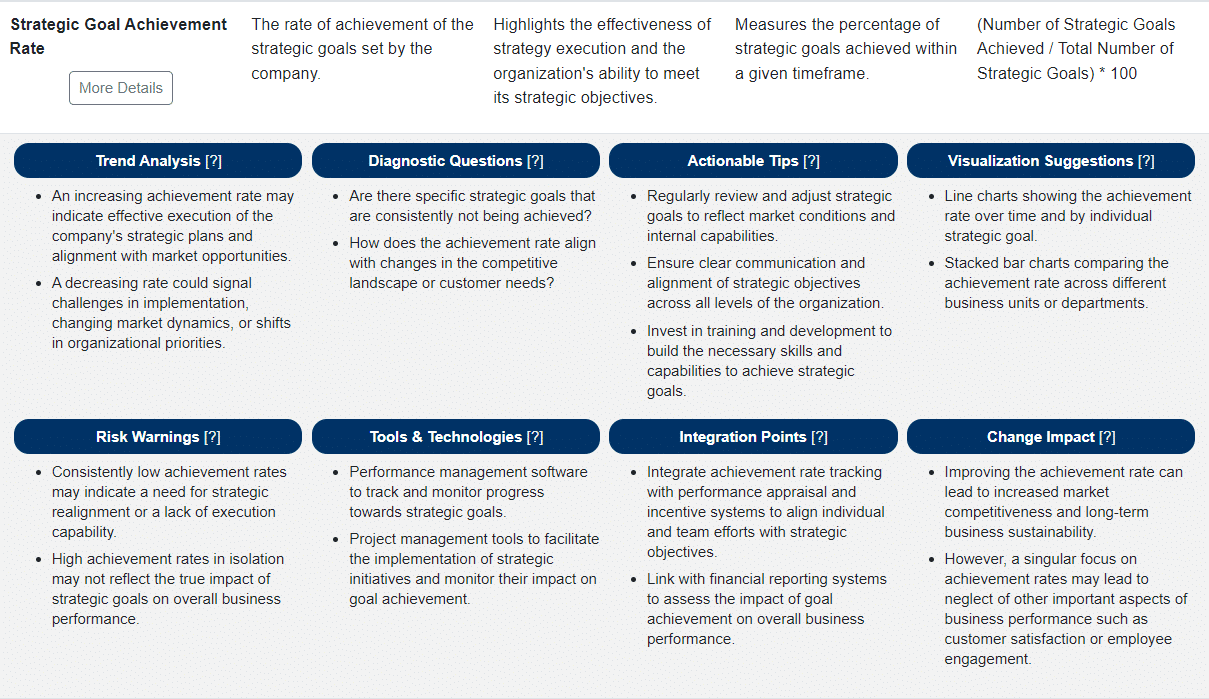Editor's Note: Take a look at our featured best practice, Cost Segregation Study: Multiple Property Class Analysis (Excel workbook). Accountants, accounting firms, and real estate property owners can all benefit from this cost segregation study (CSS) template. It makes the estimated benefit easy to figure out and has flexible assumptions for high level or detailed segregation analysis. You get a summary of cost [read more]
KPI Management: Strategic Planning KPIs
* * * *

This article aims to explore the significance of incorporating KPIs into the Strategic Planning process. Our discussion will focus on how these metrics can illuminate paths toward achieving strategic objectives, optimizing operational performance, and fostering innovation. We will demonstrate how KPIs underpin the strategic planning process, offering a quantifiable measure of progress against set goals and enabling leaders to make informed decisions that drive organizational growth and competitiveness.
Importance of Strategic Planning
In an increasingly complex and competitive business landscape, Strategic Planning emerges as a critical function for navigating uncertainties and capitalizing on new opportunities. It enables organizations to proactively shape their future, rather than reactively adapting to external changes. Effective strategic planning is predicated on a deep understanding of industry trends, customer needs, and competitive forces.
At Flevy, we have a multitude of in-depth articles and other resources on Strategic Planning:
- Executive Guide to Strategic Planning
- Strategic Planning Process
- Free Strategic Plan Template
- Strategic Planning Best Practices
Integrating KPIs into this process enhances its effectiveness by providing a clear, measurable framework for assessing strategy performance and making necessary adjustments.
Challenges to Effective Strategic Planning
Executives and senior managers often grapple with aligning short-term actions with long-term strategic goals, managing resource constraints, and adapting to rapid market changes. Other challenges include ensuring organizational agility, fostering innovation while maintaining core business operations, and accurately measuring strategy execution success.
Strategic Planning KPIs address these challenges by offering a structured approach to goal setting and performance measurement. They enable organizations to track progress, identify areas of improvement, and recalibrate strategies in alignment with evolving business objectives and market conditions.
Top 10 Strategic Planning KPIs
Selecting the most useful and relevant Strategic Planning KPIs is essential for guiding organizations towards achieving their long-term objectives. Here are the top 10 KPIs that are pivotal for Strategic Planning, each chosen for its broad relevance and strategic importance cross-industries. These KPIs are selected from the Flevy KPI Library, a robust database of over 15,000+ KPIs.
1. Strategic Goal Achievement Rate
- Definition: The percentage of strategic goals achieved within the planned timeframe.
- Relevance: This KPI measures the effectiveness of strategic planning and execution, highlighting an organization’s ability to realize its vision and long-term objectives.
2. Alignment of Strategies with Market Trends
- Definition: The degree to which organizational strategies are aligned with current and emerging market trends.
- Relevance: Ensures that the organization remains competitive and can capitalize on market opportunities by adapting its strategies to changing market conditions.
3. Organizational Agility
- Definition: The speed and efficiency with which an organization can pivot or adapt its strategies in response to market changes.
- Relevance: A high level of agility enables organizations to maintain competitiveness and respond to opportunities and threats with speed and decisiveness.
4. Financial Forecast Accuracy
- Definition: The closeness of projected financial outcomes to actual results.
- Relevance: Accurate financial forecasts are crucial for strategic planning, resource allocation, and risk management, influencing confidence in decision-making processes.
5. Market Share Growth
- Definition: The increase in an organization’s proportion of total market sales over time.
- Relevance: Reflects the success of the organization’s market strategies and its ability to outperform competitors, indicating effective strategic planning.
6. Customer Lifetime Value (CLV)
- Definition: The total value a customer is expected to bring to the organization over the entirety of the relationship.
- Relevance: CLV insights guide strategic decisions related to customer acquisition, retention, and relationship management, underpinning revenue growth strategies.
7. Innovation Pipeline Strength
- Definition: The value and potential of the organization’s pipeline of new products, services, or processes.
- Relevance: Indicates the organization’s focus on future growth and its capacity for innovation, which is critical for long-term success.
8. Employee Engagement Level
- Definition: The degree of enthusiasm and dedication employees feel towards their jobs and the organization.
- Relevance: High employee engagement is often linked to increased productivity, better performance, and the successful implementation of strategic initiatives.
9. Scenario Planning Coverage
- Definition: The extent to which strategic planning has considered various future scenarios and their potential impacts on the organization.
- Relevance: This KPI ensures that organizations are prepared for multiple future possibilities, enhancing strategic resilience and flexibility.
10. Supply Chain Resilience
- Definition: The ability of the supply chain to anticipate, adapt to, and recover from disruptions.
- Relevance: A resilient supply chain supports strategic objectives by ensuring continuity, reducing risks, and maintaining competitive advantage in times of disruption.
To dig deeper into any of these KPIs, we invite you to explore the Flevy KPI Library, which allows you to drill down into 12 attributes for each KPI in the database. Here is an example for our top ranked KPI, Strategic Goal Achievement Rate.
Case Studies and Success Stories
Driving Market Share Growth Through Strategic Alignment
A consumer goods company was facing stagnant market share growth despite increasing investments in marketing and product development. The organization decided to focus on the “Alignment of Strategies with Market Trends” and “Market Share Growth” KPIs to revitalize its strategic approach.
The company conducted a comprehensive market analysis to identify emerging consumer trends and preferences. Based on these insights, it realigned its product development and marketing strategies to better match these trends, emphasizing sustainability and digital engagement.
Outcome: Within 18 months, the company observed a significant increase in market share by 8%. The strategic realignment not only captured the attention of a broader consumer base but also positioned the company as a leader in sustainability within its industry.
Lessons Learned: The importance of continuously aligning organizational strategies with evolving market trends cannot be overstated. By closely monitoring and responding to market dynamics, organizations can ensure their offerings remain relevant and competitive, driving market share growth.
Enhancing Organizational Agility for Competitive Advantage
In the technology sector, a software company struggled to keep pace with rapid market changes and emerging technologies. The company identified “Organizational Agility” as a critical KPI to improve its strategic responsiveness and competitive edge.
To enhance agility, the company adopted flexible project management methodologies, streamlined decision-making processes, and fostered a culture of innovation and continuous learning among its workforce.
Outcome: The adoption of agile practices led to a 50% reduction in time to market for new product features and a significant improvement in customer satisfaction scores. The company’s enhanced agility allowed it to outmaneuver competitors and respond more effectively to customer needs.
Lessons Learned: Organizational agility is a key determinant of success in fast-moving industries. Companies that invest in agile practices and cultures are better equipped to adapt to changes, seize new opportunities, and maintain a competitive advantage.
Additional Resources and Further Reading
Foremost, if you are in the process of selecting or refreshing your Corporate Strategy KPIs, take a look at the Flevy KPI Library. With over 15,000+ KPIs, our KPI Library is one of the largest databases available. Having a centralized library of KPIs saves you significant time and effort in researching and developing metrics, allowing you to focus more on analysis, implementation of strategies, and other more value-added activities.
Here are other KPI Strategy and KPI Management articles we’ve published:
- Principles of KPI Selection. This article breaks down the 8 guiding principles to KPI selection and provides several case studies on how to use these principles in practice.
- Principles of KPI Maintenance. It’s important to recognize that as market conditions and strategic objectives evolve, so too must the KPIs. This article provides a disciplined approach to maintaining KPIs.
- KPI Dashboard Design & Visualization. Learn the art and science of designing KPI dashboards, including types of data visualization and how to choose among them.
- Anatomy of a Strong KPI. Learn what makes a KPI effective, discussing the characteristics of KPIs that are most impactful and how they can drive strategic business decisions.
- 10 Common Pitfalls in KPI Implementation. Learn how to identify and remediate the 10 most common pitfalls in KPI implementation. If left unfixed or as unknowns, these pitfalls can have disastrous, long-term impacts on the organization.
- KPIs and Organizational Alignment . This article discusses the concepts of strategic, tactical, and operational KPIs; as well as balancing individual, team, and organizational objectives.
- Integrating KPIs into Employee Performance. This article discusses 5 methods for integrating KPIs into individual performance metrics; and includes several case studies.
- Integrating KPIs into the Organizational Culture. This article breaks down 4 strategies for embedding KPIs into the Corporate Culture; also includes several case studies.
- Future-Proofing KPIs. Understand how to “future-proof” KPIs by understanding the impacts of emerging market trends, emerging technologies, and evolving consumer behaviors on KPIs.
- KPIs and Digital Transformation. All organizations are undergoing Digital Transformations. Learn how to define, select, and implement relevant Digital Transformation KPIs.

Do You Want to Implement Business Best Practices?
You can download in-depth presentations on 100s of management topics from the FlevyPro Library. FlevyPro is trusted and utilized by 1000s of management consultants and corporate executives.
For even more best practices available on Flevy, have a look at our top 100 lists:
- Top 100 in Strategy & Transformation
- Top 100 in Digital Transformation
- Top 100 in Operational Excellence
- Top 100 in Organization & Change
- Top 100 Management Consulting Frameworks
These best practices are of the same as those leveraged by top-tier management consulting firms, like McKinsey, BCG, Bain, and Accenture. Improve the growth and efficiency of your organization by utilizing these best practice frameworks, templates, and tools. Most were developed by seasoned executives and consultants with over 20+ years of experience.
Readers of This Article Are Interested in These Resources

|
|
145-slide PowerPoint presentation
|
|
Excel workbook
| |||
About Flevy Management Insights
Top 10 Recommended Documents














